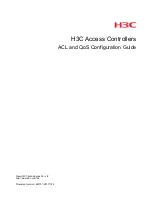
Controller Security
Summit WM3000 Series Controller System Reference Guide
322
●
IP traffic by using IP ACL
●
Non-IP traffic by using MAC addresses.
Both IP and non-IP traffic on the same Layer 2 interface can be filtered by applying both an IP ACL
and a MAC ACL to the interface.
You cannot apply more than one IP ACL and one MAC ACL to a Layer 2 interface. If an IP ACL or
MAC ACL is already configured on a Layer 2 interface and a new IP ACL or MAC ACL is applied
to the interface, the new ACL replaces the previously configured one.
Wireless LAN ACLs
Wireless LAN ACLs filter/mark packets based on the wireless LAN from which they arrive rather than
filtering packets on Layer 2 ports.
In general, a Wireless-LAN ACL can be used to filter wireless to wireless, wireless to wired and wired
to wireless traffic. Typical wired to wired traffic can be filtered using a Layer 2 port based ACL rather
than a WLAN ACL.
Each WLAN is assumed to be a virtual Layer 2 port. Configure one IP and one MAC ACL on the
virtual WLAN port. In contrast to Layer 2 ACLs, a WLAN ACL can be enforced on both the Inbound
and Outbound direction.
ACL Actions
Every ACE within an ACL is made up of an action and matching criteria. The action defines what to do
with the packet if it matches the specified criteria. The following actions are supported:
●
deny
— Instructs the ACL not to allow a packet to proceed to its destination.
●
permit
—Instructs the ACL to allows a packet to proceed to its destination.
●
mark
—Modifies certain fields inside the packet and then permits them. Therefore, mark is an action
with an implicit permit.
●
VLAN 802.1p priority.
●
TOS/DSCP bits in the IP header.
NOTE
A Permit All ACL is not supported when using NTP. If a Permit All ACL is used with NTP, the client is not able to
synchronize with the NTP server.
NOTE
Only a Port ACL supports a mark action. With Router ACLs, a mark is treated as a permit and the packet is allowed
without modifications.
Precedence Order
The rules within an ACL are applied to packets based on their precedence values. Every rule has a
unique precedence value between 1 and 5000. You cannot add two rules’ with the same precedence
value.
Summary of Contents for Summit WM3000 Series
Page 139: ...Summit WM3000 Series Controller System Reference Guide 139 ...
Page 478: ...Diagnostics Summit WM3000 Series Controller System Reference Guide 478 ...
Page 480: ...Customer Support Summit WM3000 Series Controller System Reference Guide 480 ...
Page 498: ...AP Management from Controller Summit WM3000 Series Controller System Reference Guide 498 ...
Page 512: ...Troubleshooting Information Summit WM3000 Series Controller System Reference Guide 512 ...
Page 513: ......
















































